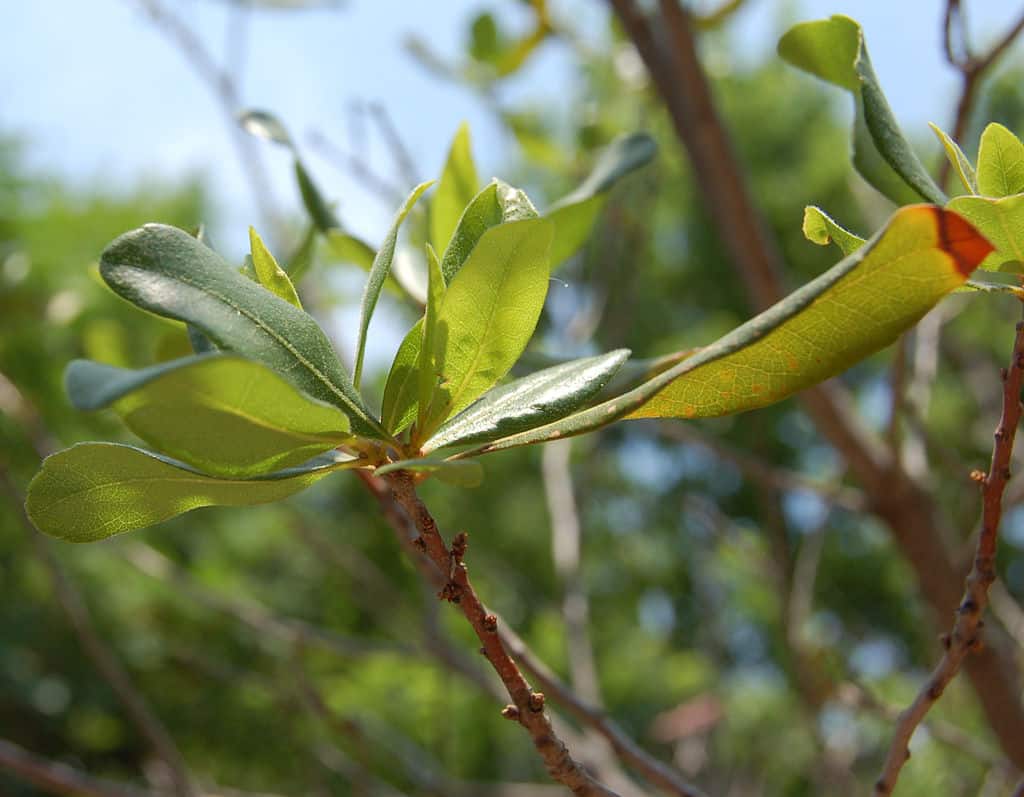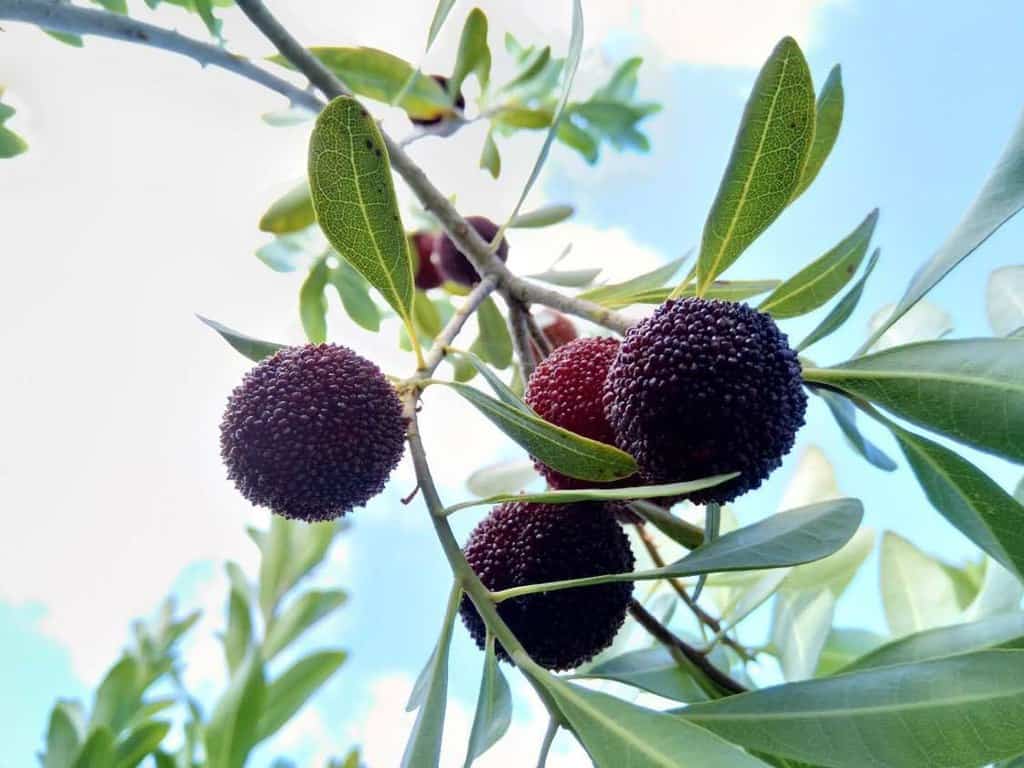The Northern Bayberry is found on the east coast of the United States down into Texas. In the late fall through late winter, the female plants grow ripe with silver berries. If you’ve ever gotten up close, you’ve likely noticed that they have a familiar scent. This is because bayberries have mostly been used to make candles. But are they also something you can collect and eat?
Are Bayberries Edible?
For the most part, bayberries are considered edible. There hasn’t been a lot of scientific research on the berries as a food source, but what has been done has led many to believe that the berries may contain carcinogens known to cause cancer. For this reason, they’re not recommended in large doses, and it’s advised that children and pregnant people or those who are nursing avoid eating bayberries.
While others may find the bayberries safe enough to ingest in small amounts, the fruit isn’t typically something that people seek out to snack on. Bayberry fruit has a single large seed with little edible flesh, so they’re just less enjoyable.
People who have bad reactions to bayberries experience nausea, vomiting, diarrhea, and other stomach upset.
If you’re foraging for wild northern bayberry, always be sure to check multiple trusted sources when identifying the plant. It’s also a good practice to eat a single berry and wait two hours to see how your digestive system reacts before eating more.
When bayberry plants are used for culinary purposes, it’s usually as a flavoring. Bayberry fruit and leaves can be used as a bay leaf substitute in many recipes. Most often, bayberry leaves are used as a flavoring for soup, where the leaves are removed before eating. The leaves from the plant can be used to make a green dye.


Bayberries Are Mostly Known For One Thing
Bayberry candles are a tradition that dates back to the early American colonists. They became a popular choice after people started boiling the berries and leaves, only to discover a thick layer of wax on the water’s surface. The tallow candles (made out of animal fat) that they burned tended to smoke and give off a rancid odor, while the bayberry wax created clean-burning candles that give off a pleasant balsamic odour.
Even today, people use bayberry candles on special occasions such as Christmas Eve and New Year’s Eve. There is a legend that says burning the bayberry candle will bring you good luck.
Bayberries have become well-known as aromatic candles. Most of the major brands in North America have a bayberry option in their line.
While it’s mostly been used to make candles, you can also find it as a popular option in soaps and other bath care products. If you pick a fresh bayberry, you’ll notice there is a waxy feel to the outside of the fruit.
Bayberry candles have now made the bayberry scent recognizable to many. In fact, its scientific name is myrica pensylvanica. “Myrica” has its roots in a Greek word that translates as “fragrance”.


Different Kinds Of Bayberry
The northern bayberry is what you’ll likely find in most of the United States, but it’s not the only one of its kind. It’s closely related to the wax myrtle, often called the southern wax myrtle or southern bayberry. The wax myrtle is also found in Texas and is easy to confuse with the northern bayberry, as both grow as large shrubs and are often spotted on coastal dunes. Some of the key differences are that the southern wax myrtle is often larger and grows faster than its northern counterpart. The wax myrtle is from the same scientific family and is known as the myrica cerifera.
Another variation is the myrica rubra. This one is more difficult to get confused with the others since it natively grows in eastern Asia. While the northern bayberry grows as a tall shrub or small tree, the myrica rubra is typically a taller tree. It’s most well-known as the Chinese bayberry.
Medicinal Uses Of Bayberry
There is no scientific evidence to support the medicinal uses of bayberry, and in general, what has been recorded has been more sparse than what we know about a lot of other kinds of wild berries. With that in mind, people have found medicinal uses for the berries and root bark.
Bayberry has been used to help with the treatment of fevers and cold symptoms, including nausea, diarrhea, and general stomach upset. Some people have used bayberry as a gargle to help with the pain of a sore throat. It’s also been applied topically to help with skin wounds. It does tend to dry out the skin.
Where The Northern Bayberry Grows
The northern bayberry can grow in poor soil and partial shade. It’s often found growing on coastal dunes in sandy soil. The shrubs can still thrive in salt spray and with high winds pushing the plant around. If it’s growing somewhere humid where the soil is going to stay naturally moist, it doesn’t require much watering.
However, your bayberry plant will be the happiest when growing in well-drained soil. Many anecdotal reports have said that the best-tasting berries have grown in moist soil, warm weather, and full sun.
Many people plant bayberry in their yards because they can grow in many different conditions, but also because they are considered nitrogen fixers. They are able to grow in both poor sandy soil and moist soil because they are able to extract nitrogen from the air. In other words, they are self-fertilizing plants that will add nutrients to the soil. They have structures called root nodules with the bacteria frankia. These root nodules are what make it so the northern bayberry can grow happily in so many different kinds of conditions. They change their environment to be more suitable for their needs, which also means that people have planted bayberry to reclaim land, changing it for the better in the future.
More Than Candles
The pleasant aroma of the bayberry plant has turned them into a popular choice in the fragrance industry. Over time, people are discovering how well-suited the shrubs are for landscaping in difficult soils, turning them into a more popular option at gardening stores. And, occasionally, they’re proving to be an interesting bay leaf substitute for culinary purposes. While not the most versatile of berries for eating, they’re proving they’re more than their reputation as pleasant candles.
Recent Posts
The only venomous snakes in Washington State are Northern Pacific Rattlesnakes. The Northern Pacific Rattlesnake (Crotalus oreganus oreganus) is a sub-species of the Western Rattlesnake. Anyone...
Skunks are not classified as true hibernators. But they go into a state of torpor when the weather gets cold. Skunks are light sleep hibernators, along with opossums, bears, and raccoons. ...
